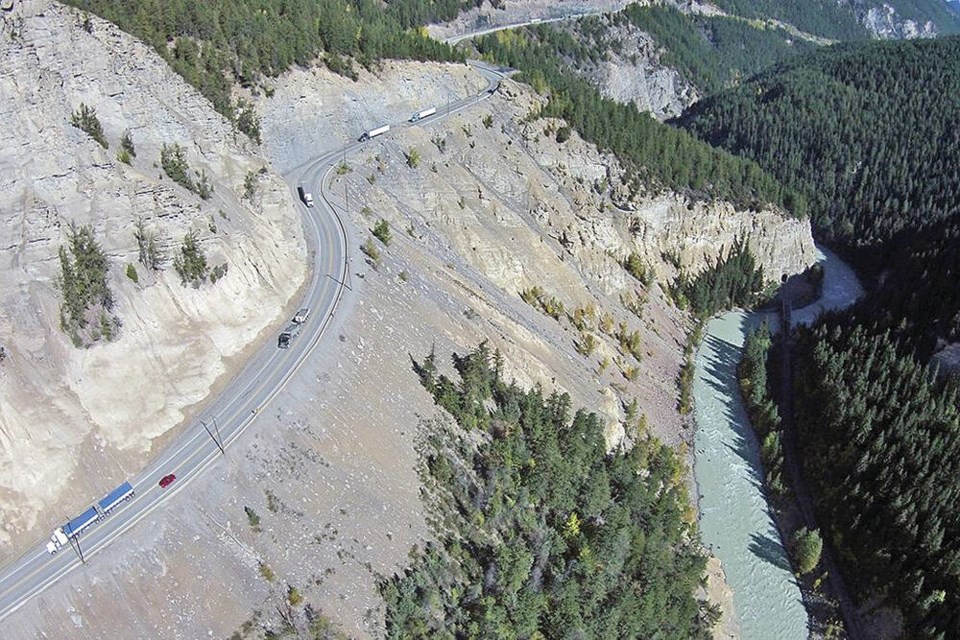A friend driving to Alberta last week made the mistake of not checking online for highway conditions. Highway 1 through Kicking Horse Canyon, east of Golden, closes nightly for construction, catching my friend in Golden at 10:30 p.m. without a hotel room booked.
The alternative was a 1.5-hour detour through Radium.
The $601-million project is the final, fourth stage of upgrades to the canyon highway. When finished, likely by the end of 2023, the highway will be a wider, smooth 21st-century high-speed roadway, with room even for cyclists.
Where the highway isn’t being twinned, a median will separate vehicles from oncoming traffic. Aging bridges will be replaced, and the last remaining curves that have caused drivers’ blood-pressure levels to spike and knuckles to whiten for decades will be straightened, defying the canyon’s straitening confines.
Kicking Horse Canyon has long been considered one of Canada’s most dangerous highway stretches. Between 1996 and 2001, 700 accidents on the winding road caused 21 deaths. From 1991 to 2000, almost 400 people were injured. For years, the accident rate on that stretch was double the provincial average.
The route has always been spectacularly scenic and treacherous.
When it was decided in the 1950s that the new Trans-Canada Highway would cross the Alberta–B.C. border at Kicking Horse Pass, a highway of sorts already existed through the canyon. The road followed the route punched through the pass for the Canadian Pacific Railway in the late-1800s.
A 1927 guide to the then-new “Kicking Horse Trail Scenic Highway from Lake Louise, Alberta to Golden, British Columbia” describes the route appropriately. Author M.B. Williams’s prose mirrors the winding, narrow dirt road that cut through old-growth, over avalanche chutes, along cliffs and across one-lane timber bridges over the tumbling glacial river.
“No room in such narrow quarters, it is clearly evident, for a modern motor road. Faced with this problem the highway engineers lifted their eyes higher up. As Hector [“Sir James Hector, the intrepid discoverer of the pass,” while guided by a member of the Stony First Nation] had pointed out some sixty years before in his journal, there is nothing like a narrow valley for limiting the choice of a road. There was no choice here but to build along the side wall of the canyon.”
Williams waxes on: “Some day some poet may praise worthily the pathfinders and roadmakers of this new continent, the men who made the way straight in the wilderness for those who were to come.”
The guidebook is as influenced by the times, traditions and circumstances it was created in as the highway it describes.
Now, nearly a century on, few driving the Kicking Horse highway likely consider the original road’s engineers and builders or what Williams witnessed and described with her many adjectives as they speed along at 90 km/h. Their speed and gas gauge, the vehicles around them, the weather and road conditions, ongoing construction, the distance to the next restroom, and making good time to Golden or Lake Louise preoccupy them instead.
“For forty-seven miles along its western journey the road is to accompany the turbulent river, on its tempestuous course through Yoho National Park, and on its last mad rush through the Kicking Horse canyon, until it flings itself panting and exhausted upon the broad bosom of the Columbia and is borne upon its mighty tides to the far Pacific.”
As much as my friend grumbled, it was his own poor planning that brought him to the highway barricades after the evening closure.
About M.B. Williams
Hired in 1911 as a file clerk in the office of the fledgling Dominion Parks Branch (precursor of Parks Canada) in Ottawa, Mabel Berta Williams had never travelled to Western Canada and was not at all outdoorsy.
But 10 years on, she was the agency’s main promotional writer and oversaw a team of seven. She extensively toured the country’s western national parks by rail, horse, canoe and Model T, authoring guidebooks to promote tourism in the parks and producing scripts for 50 of the parks’ documentary and travel films.
See environmentandsociety.org/exhibitions/mb-williams for more about Williams and her Kicking Horse highway guide.
>>> To comment on this article, write a letter to the editor: [email protected]



